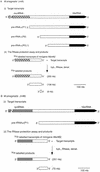Effects of growth conditions on expression of mycobacterial murA and tyrS genes and contributions of their transcripts to precursor rRNA synthesis
- PMID: 10419962
- PMCID: PMC103595
- DOI: 10.1128/JB.181.15.4617-4627.1999
Effects of growth conditions on expression of mycobacterial murA and tyrS genes and contributions of their transcripts to precursor rRNA synthesis
Abstract
All mycobacteria studied to date have an rRNA operon, designated rrnA, located downstream from a single copy of the murA gene, which encodes an enzyme (EC 2.5.1.7) important for peptidoglycan synthesis. The rrnA operon has a promoter, P1(A), located within the coding region of murA, near the 3' end. Samples of RNA were isolated from Mycobacterium tuberculosis at different stages of the growth cycle and from Mycobacterium smegmatis grown under different conditions. RNase protection assays were used to investigate transcripts of both murA and rrnA. Transcription of murA was found to continue into the 16S rRNA gene, as if murA and rrnA form a hybrid (protein coding-rRNA coding) operon. During the growth of M. tuberculosis, the hybrid operon contributed approximately 2% to total pre-rRNA. Analysis of M. smegmatis RNA revealed that the level of murA RNA depended on the growth rate and that the patterns of expression during the growth cycle were different for murA and rrnA. M. smegmatis has a second rRNA operon, rrnB, located downstream from a single copy of the tyrS gene, encoding tyrosyl-tRNA synthetase. Transcription of tyrS was found to continue into the 16S rRNA gene rrnB. The hybrid tyrS-rrnB operon contributed 0.2 to 0.6% to rrnB transcripts. The pattern of tyrS expression during the growth cycle matched the pattern of rrnB expression, reflecting the essential role of TyrS and rRNA in protein biosynthesis.
Figures








Similar articles
-
Characterization of an rRNA operon (rrnB) of Mycobacterium fortuitum and other mycobacterial species: implications for the classification of mycobacteria.J Bacteriol. 2002 Feb;184(4):1078-88. doi: 10.1128/jb.184.4.1078-1088.2002. J Bacteriol. 2002. PMID: 11807068 Free PMC article.
-
Roles of multiple promoters in transcription of ribosomal DNA: effects of growth conditions on precursor rRNA synthesis in mycobacteria.J Bacteriol. 1998 Nov;180(21):5756-61. doi: 10.1128/JB.180.21.5756-5761.1998. J Bacteriol. 1998. PMID: 9791129 Free PMC article.
-
Organization and Characterization of the Promoter Elements of the rRNA Operons in the Slow-Growing Pathogen Mycobacterium kumamotonense.Genes (Basel). 2023 Apr 30;14(5):1023. doi: 10.3390/genes14051023. Genes (Basel). 2023. PMID: 37239384 Free PMC article.
-
Functional analysis of transcription of the Mycobacterium tuberculosis 16S rDNA-encoding gene.Gene. 1994 Oct 11;148(1):113-8. doi: 10.1016/0378-1119(94)90243-7. Gene. 1994. PMID: 7926824
-
Long range transcriptional control of virulence critical genes in Mycobacterium tuberculosis by nucleoid-associated proteins?Virulence. 2012 Jul 1;3(4):408-10. doi: 10.4161/viru.20918. Epub 2012 Jun 22. Virulence. 2012. PMID: 22722242 Free PMC article. Review. No abstract available.
Cited by
-
Characterization of an rRNA operon (rrnB) of Mycobacterium fortuitum and other mycobacterial species: implications for the classification of mycobacteria.J Bacteriol. 2002 Feb;184(4):1078-88. doi: 10.1128/jb.184.4.1078-1088.2002. J Bacteriol. 2002. PMID: 11807068 Free PMC article.
-
Analysis of expression profile of mammalian cell entry (mce) operons of Mycobacterium tuberculosis.Infect Immun. 2003 Oct;71(10):6083-7. doi: 10.1128/IAI.71.10.6083-6087.2003. Infect Immun. 2003. PMID: 14500535 Free PMC article.
-
Mycolicibacterium smegmatis, Basonym Mycobacterium smegmatis, Expresses Morphological Phenotypes Much More Similar to Escherichia coli Than Mycobacterium tuberculosis in Quantitative Structome Analysis and CryoTEM Examination.Front Microbiol. 2018 Sep 11;9:1992. doi: 10.3389/fmicb.2018.01992. eCollection 2018. Front Microbiol. 2018. PMID: 30258411 Free PMC article.
-
A spectrophotometric assay for quantitative measurement of aminoacyl-tRNA synthetase activity.J Biomol Screen. 2013 Apr;18(4):490-7. doi: 10.1177/1087057112465980. Epub 2012 Nov 7. J Biomol Screen. 2013. PMID: 23134734 Free PMC article.
-
Mycobacterium avium subsp. paratuberculosis in Veterinary Medicine.Clin Microbiol Rev. 2001 Jul;14(3):489-512. doi: 10.1128/CMR.14.3.489-512.2001. Clin Microbiol Rev. 2001. PMID: 11432810 Free PMC article. Review.
References
-
- Boros I, Csordás-Tóth E, Kiss A, Török I, Udvardy K, Venetianer P. Identification of two new promoters probably involved in the transcription of a ribosomal RNA gene of Escherichia coli. Biochim Biophys Acta. 1983;739:173–180. - PubMed
-
- Bremer H, Dennis P P. Modulation of chemical composition and other parameters of the cell growth rate. In: Neidhardt F C, Ingraham J L, Low K B, Magasanik B, Schaechter M, Umbarger H E, editors. Escherichia coli and Salmonella typhimurium: cellular and molecular biology. Washington, D.C: American Society for Microbiology; 1987. pp. 1527–1542.
-
- Clarke P H, Meadow P M. Evidence for the occurrence of permeases for tricarboxylic acid intermediates in Pseudomonas aeruginosa. J Gen Microbiol. 1959;20:144–155. - PubMed
-
- Cole S T, Brosch R, Parkhill J, Garnier T, Churcher C, Harris D, et al. Deciphering the biology of Mycobacterium tuberculosis from the complete genome sequence. Nature. 1998;393:537–544. - PubMed
Publication types
MeSH terms
Substances
LinkOut - more resources
Full Text Sources
Molecular Biology Databases

